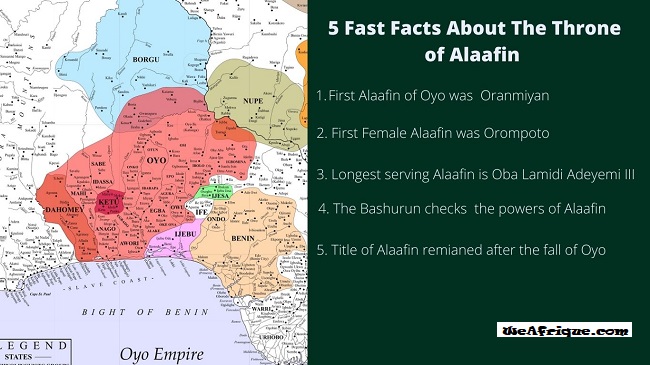- The reign of the Alaafins began in the year 1300 when Oranmiyan founded the Old Oyo Empire and served as the first Alaafin
- 45 Alaafins have ruled from the year 1300 to the present, with the current king Oba Lamidi Adeyemi being on the throne for more than 50 years
- Since the existence of Oyo, there has been one female Alaafin, Oba Orompoto
Alaafin of Oyo is widely considered to be the political leader of the Yoruba people. Aside from his political authority, he is the only Yoruba king that is vested with the power to bestow important chieftaincy titles such as Aare Ona Kankafo, Basorun, and Iyalode in the entire Yorubaland.
Apart from his political significance to the Yoruba race, he is the paramount ruler of Oyo. Since the inception of the Old Oyo Empire to date, more than 40 Alaafins have ruled, passing the baton from one descendant of Oranmiyan to the next.
Here is everything you need to know about the traditional throne.
Origin Of The Alaafin

The word Alaafin means ‘The Owner of the Palace’ in the Yoruba language. It is the title of the emperor of the old Oyo empire, and present-day Oyo town in south-western Nigeria, West Africa.
According to Yoruba history and mythology, the Alaafin of Oyo is one of the seven sons (Oranmiyan) of Oduduwa, regarded by the Yorubas as a divine king who held the title of the Olofin of Ile-Ife. It was said that Oranmiyan is the biological son of Ogun, but was adopted by Oduduwa.
What remains unclear about his birth is the fact that both Ogun and Oduduwa were said to have had an affair with his mother. It was said that Ogun was the first to have a sexual relationship with Oranmiyan’s mother after which she became pregnant. Oduduwa desired her and also had a sexual relationship with her while she was still pregnant. The result of the two affairs led to the birth of Oranmiyan, the first Alaafin of Oyo.
The mythology went on to state that the Alaafin later became kings and founders of the Yoruba civilization, seen today. More so, when the great Oyo Empire fell in 1835, the title was retained.
Comparison Between The Alaafin of Oyo and The Oni of Ife
Arguments have sprung from various quarters regarding the respect the throne of Oni of Ife is accorded in respect to the Alaafin. Proponents of the argument don’t see why the Oni should be placed above the former since Ife was part of the Old Oyo Empire which was under the control of the Alaafin then.
The Alaafins are responsible for the expansion of the Oyo Empire. They are well known in historical accounts for their well-coordinated warfare and the spread of Yoruba influence across West Africa. Even the colonialist had a difficult time contending with the powers of the Alaafins of the old Oyo empire.
While the opponent lay the foundation for their arguments on Yoruba mythology and history which says the Yorubas traced their origins to Ife, thus imbuing the Oni with the role of a ‘spiritual’ guardian. They also stated that the Alaafin became politically powerful due to migration and war within the Yoruba race. Therefore, the Alaafin is seen as a political leader, while the Oni is seen as a spiritual leader.
However, there are those who hold a neutral opinion that both Obas (kings) are important and powerful, thus, none is more popular than the other. While these arguments go on, the fact still remains that whenever a new Alaafin, Oni, or any king in Yorubaland is installed, they must visit Oranmiyan’s grave in Ile Ife to handle the IDA ORANMIYAN (Oranmiyan’s sword) as part of their coronation.
How Many Alaafins Ruled Oyo?
Since from the beginning of the Old Oyo Empire to the present-day Oyo town, 45 Alaafins have ruled this great Yoruba Land. They are:
- Oranyan (Oranmiyan)
- Ajaka (dethroned)
- Shango
- Ajaka (re-installed)
- Aganjusola
- Kori
- Oluaso
- Onigbogi
- Ofinran
- Eguguojo
- Orompoto
- Ajiboyede
- Abipa
- Obalokun
- Oluodo
- Ajagbo
- Odarawu
- Kanran
- Jayin
- Ayibi
- Osiyango
- Ojigi
- Gbaru
- Amuniwaye
- Onisile
- Labisi
- Awonbioju
- Agboluaje
- Majeogbe
- Abiodun
- Aole
- Adebo
- Maku
- Majotu
- Amodo
- Oluewu
- Abiodun Atiba
- Adelu
- Adeyemi
- Lawani Agogoija
- Ladigbolu
- Adeniran Adeyemi II
- Bello Gbadegesin
- Lamidi Olayiwola Adeyemi III
7 Facts You Were Never Told About The Throne Of The Alaafin Of Oyo
1. Who was the first to sit on the throne?
Oranmiyan was said to be the first Alaafin of Oyo. According to history, he was the first to be crowned Oba of Benin, but he left Benin to found Oyo in the year 1300. He later installed his son Ajaka as the Alaafin, who is mostly regarded as the first Alaafin.
Unfortunately for Ajaka, he was overthrown by his brother Shango for being a weak king. However, he was later reinstalled as the third Alaafin after Sango’s reign came to an end.
Also See- 7 African Kings That have Ruled Longest
2. Who is the longest-ruling monarch that sat on the throne in modern times?
The longest-serving Alaafin is Oba Lamidi Adeyemi III. He received his staff of office on 14th January 1971 in Oyo by then Military Governor of Western State, Brigadier Robert Adeyinka Adebayo. Since then, he has been sitting on the throne discharging the duties of a king as those before him.
On the 14th January 2021, he celebrated the 50th golden anniversary of his reign as the 45th Alaafin of Oyo. According to reports, no Alaafin in modern times has stayed 50 years on the throne except him. The closest was Alaafin Siyanbola Onikepe Oladigbolu whose reign lasted from 1911 to 1944 (33 years).
3. Which of the monarchs had the shortest reign on the throne in modern times?
While Oba Lamide Adeyemi III holds the record of the longest-serving Alaafin in modern times, Alaafin Amodo’s reign is the shortest. He only ruled from 1833 to 1835 (two years).
4. Was there ever a female monarch on the throne?
Out of the 45 Alaafins that have ruled Oyo, one of them was a woman called Alaafin Orompoto. She made history as the first female Alaafin.
She was the daughter of Alaafin Ofinran and the granddaughter of Alaafin Onigbogi. Her reign lasted from 1554 to 1562 (8 years).
She ascended the throne following the death of her brother Alaafin Eguguoju who died in his prime without a male successor. Her younger brothers Prince Ajiboyede and Prince Tella were very young at the time, and couldn’t sit on the throne.
Even though her decision to assume the throne was met with stiff opposition from the chiefs and elders who were already planning on who install as the next Alaafin. She orchestrated a plan to wear male clothing after telling the elders she wants to prove her masculinity as a man.
The elders on the other hand see it as the best way to ridicule her. When the day arrived, she climbed the podium, removed her cap to reveal her hair which has been cut low and showed her chest. The elders were not impressed, so, she went ahead and took off her trousers, and as oral history said, the elders saw a penis and a scrotum.
It was at the moment that they all prostrated and she was enthroned as Alaafin Orompotaniyun.
5. The current Alaafin, Oba Lamidi Adeyemi III has ruled with 9 Olubadans
Oba Lamidi Adeyemi III, the present Alaafin has ruled with 9 Olubadans of Ibadanland since he ascended the throne in 1971. At the time he was enthroned, Oba Salawu Akanni was the Olubadan, but he died a year later according to reports. After Oba Akanni, there have been 8 others inclduing the present Olubadan, Oba Saliu Akanmu Adetunji, Aje Ogunguniso I.
Below is a list of the Olubandans since Oba Adeyemi III became the 45th Alaafin:
- Oba Salawu Akanni Aminu (1965-1971)
- Oba Shittu Akintola Oyetunde II (1917-1976)
- Oba Gbadamosi Akanbi Adebimpe (1976-1977)
- Oba Danield Tayo Akinbiyi (1977-1982)
- Oba Yusuf Oloyede Asanike (1982-1994)
- Oba Emmanuel Adegboyega Operinde (1994-1999)
- Oba Yunusa Ogundipe Arapasowu (1999-2007)
- Oba Samuel Odulana Odugade (2007-2016)
- Oba Saliu Akanmu Adetunji (2016- 2022)
6. Why was the throne taken from Ajaka?
According to Yoruba history, Ajaka was made the Alaafin by his father Oranmiyan. He was described as a peaceful man, and this was seen as a weakness.
He became drowned in running the palace affairs and allowed his warriors more freedom than is needed. This attitude caused him the throne.
He was dethroned and his brother Shango was made Alaafin in his place. Subsequently, he was reinstalled after the death of Shango
7. Checks and balances were introduced to prevent the Alaafins from being autocratic
At the height of the popularity of the Old Oyo empire, a perfect system was put in place to check the autocratic and despotic tendencies of the Alaafins. That system was made up of a group of noblemen known as ‘Oyo Mesi’. They were the king’s advisors and sacred officials, playing judicial and administrative roles.
They are so powerful that their consent is needed to enthrone an Alaafin. And whenever the ruler becomes a tyrant, the Bashorun (Prime Minister), presents the case before the council to vote.
After this, a traditional rite is performed where the Bashorun would bring a calabash that is either empty or filled with eggs of a parrot, and present it to the king. Once he sees this, by obligation, he immediately relinquishes the throne by way of ritual suicide.
For instance, there was a Bashorun named Gaa who was said to have disposed and killed four successive Alaafins during his time. The first was Alaafin Labisi, killed after 17 days on the throne; followed by Alaafin Awonbioju who spent 130 days; Alaafin Agboluaye ruled from 1750 to 1772, and Alaafin Majeogbe from 1772 to 1773.
The Oyo Mesi is made up of the following members:
- The Bashorun (Prime Minister)
- The Agbaakin (High Priest of Oranmiyan)
- The Samu (Sacrificial Minister)
- The Alapini (High Priest of Egungun)
- The Laguna (Roving Ambassador)
- The Akiniku (Chief of Defence)
- The Ashipa (Mayor of the Capital)





















Discussion about this post